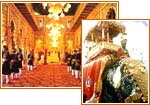


|
|
 |
| HOME | TRAVEL | TRAVELOG | ||

Riding with the Maharaja ... a Mysore Dassera
M A Sreenivasan
Much before that, Krishnaraja Wodeyar himself had me appointed president of the Mysore Municipal Council and chairman of the City Improvement Board in 1934. I held that tenure for five long years. It was a rich experience : the durbars in the palace, the command recitals of famous musicians, the chance of meeting and entertaining important visitors to the city like Pandit Jawaharlal Nehru and his wife Kamala, Somerset Maugham and Eric Linklater. I also had the privilege of riding in processions on the Maharaja’s birthday and on Vijayadashami during Dassera. Senior government officers and prominent citizens – durbarees as they were called – usually walked in the processions. When I came to Mysore, I asked if I might ride in them. To my delight, the request was readily granted by the Maharaja, who, fifteen years earlier, had given me prizes for riding. A well built black horse was made available to me for the procession. I was so excited over the privilege that I forgot to check two things. First, whether the animal was a shier and had ever been in procession. Secondly, the fact that I had to present flowers to the Maharaja at least twice on the way in different capacities. That involved dismounting and mounting in brocaded long coat, white flannel trousers and lace turban, and finding a way through the throng of spectators lining the street. I was one of three riders at the head of the procession. Even before the main body of the procession had emerged from the ornamental gate beside the temple, my mount started fretting and curvetting with excitement. Despite my attempts to calm him, he kept pulling down the reigns, refusing to stand in line with my companions, and moving sideways. The tempo of his strutting and dancing remained undiminished throughout the procession as he went on moving sideways, keeping one eye, or both, on the elephant’s behind. The spectators, standing three rows strong on both sides of the route, were watching from every available perch on housetop and terrace, cheering and enjoying the unusual scene and hoping that the horse might add to the fun by unseating the rider. I was relieved to disappoint them: the mayor remained untoppled. Spectacular were the torchlight parade and march past on the brightly illuminated Bannimantap parade ground, the Maharaja on horseback receiving the salute. More spectacular was the gorgeous procession back to the palace, with electric batteries mounted on trolleys, floodlighting on the elephant and howdah, the crowning event and a superb climax to a many splendoured festival. That was the Dassera that was.
Excerpted from the Of the Raj, Maharajas and Me by M A
Sreenivasan, former minister of Mysore and dewan of Gwalior. This book,
published by Ravi Dayal in 1991 and distributed by Orient Longman Ltd,
is more an elegant reflection of the times in which he lived and
participated, than a biography.
Sreenivasan, who moved on to a better
world in January, after celebrating his 100th birthday just
before Dassera last year, was a member of the Constituent Assembly of
India and involved in the transfer of power to Indian hands in 1947.
This excerpt was selected by M A Sreenivasan’s granddaughter M D Riti.
|
|
| Tell us what you think of this feature | |
|
|
|
|
HOME |
NEWS |
BUSINESS |
CRICKET |
MOVIES |
CHAT
INFOTECH | TRAVEL | LIFE/STYLE | FREEDOM | FEEDBACK |
|